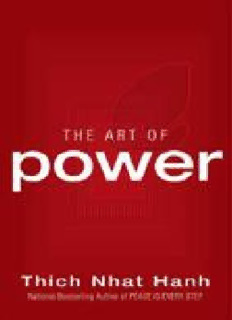
The Art of Power PDF
Preview The Art of Power
The ART of POWER Thich Nhat Hanh Contents Foreword Introduction 1 True Power 2 Handling Power Skillfully 3 The Art of Mindfulness 4 Getting What We Really Want 5 The Secret of Happiness 6 Boundless Love 7 Being Present at Home and at Work 8 Taking Care of Nonbusiness 9 Sparking a Collective Awakening Appendix A: Meditations to Cultivate Power Appendix B: Work and Pleasure: The Example of Patagonia About the Author Cover Copyright About the Publisher Foreword In January 2001, I was privileged to accompany Thich Nhat Hanh and his longtime assistant, Sister Chan Khong, to the World Economic Conference, held each year in Davos, Switzerland. Thich Nhat Hanh had been invited along with other prominent religious leaders from around the planet to meet and discuss how spiritual values could be used to help resolve global issues. Before an estimated thirty heads of state, two hundred of the world’s richest men and women, and a few thousand of the most influential movers and shakers alive, Thich Nhat Hanh spoke with love, compassion, and total fearlessness. He was not there to seek support or approval from the great and famous. He was there hoping to awaken in them their best, to help them change the world by touching their own true selves. In a gathering dedicated to wealth, influence, and power in all its fabulous manifestations, he spoke in a soft and quiet voice. He asked nothing of them, only reminding them to please always remember their common humanity. On its Web site, the World Economic Forum proudly displays the motto “Committed to Improving the State of the World.” That day, in Davos, Switzerland, Thich Nhat Hanh asked everyone to adopt the motto “Committed to Improving the State of Every Heart.” Thich Nhat Hanh has spent his life speaking truth to power and truth to the powerless. He is a determined revolutionary—not one who asks us to mount the ramparts in anger, but rather a revolutionary of the human spirit, a revolutionary of understanding and of love. Born in 1926, he grew up in Vietnam, one of the most war-torn countries of the twentieth century. At age sixteen he was ordained as a Buddhist monk. From the beginning he was that rare person who could undertake multiple vocations and excel at all of them. Simultaneously he was a Buddhist monk, scholar, poet, writer, reformer, and social activist. And he did all of this as a young man in a time and place of immeasurable turmoil and suffering. He lived through the invasion of his homeland by the Japanese in 1941, the return of the French at the end of the Second World War, the guerilla war that followed and became what is known in Vietnam as the American war and in the United States as the Vietnam War. As a reformer and activist, he helped found many groundbreaking institutions, including the An Quang Buddhist Institute, which became one of the foremost centers of Buddhist studies in South Vietnam, and the La Boi Press, which established itself as one of the country’s most prestigious publishing houses. He was also a founder of the School of Youth for Social Service, called “the little Peace Corps” by the American press. During the worst years of the war, he and his assistant, Sister Chan Khong, risked their lives along with thousands of other young people, including many Buddhist monks and nuns, by going into the countryside to establish schools and health clinics and to rebuild villages destroyed by the fighting. During this time he was also editor-in-chief of the official publication of the Unified Buddhist Church and the author of numerous books of poetry, Buddhist psychology, and social commentary. In 1966 he traveled to the United States to call for peace. During this trip he spoke to the American public to “describe the aspirations and the agony of the voiceless masses of the Vietnamese people.” He also met with many important figures in America, including Dr. Martin Luther King Jr., who nominated him for the 1967 Nobel Peace Prize. In 1969 he led the Buddhist Peace Delegation to the Paris Peace Talks, organized to negotiate an end to the war in Vietnam. In 1973, because of his peace work, he was denied permission to return home. But being exiled did not deter him. Over the past forty years of living in the West, he has established himself as one of the most influential and respected spiritual leaders in the world. He has continued his social activism through the support of over one hundred schools and programs of village improvement in his homeland. He has also continued to be involved with peace and social justice movements around the world, speaking out on issues from AIDS to the Iraq War. With more than one hundred books in print in over thirty languages and a year-round teaching schedule, his impact continues to grow worldwide. From his hermitage at Plum Village in southwestern France, he guides numerous communities of monks, nuns, and
Description: